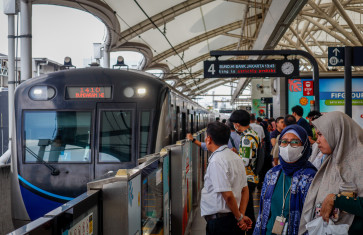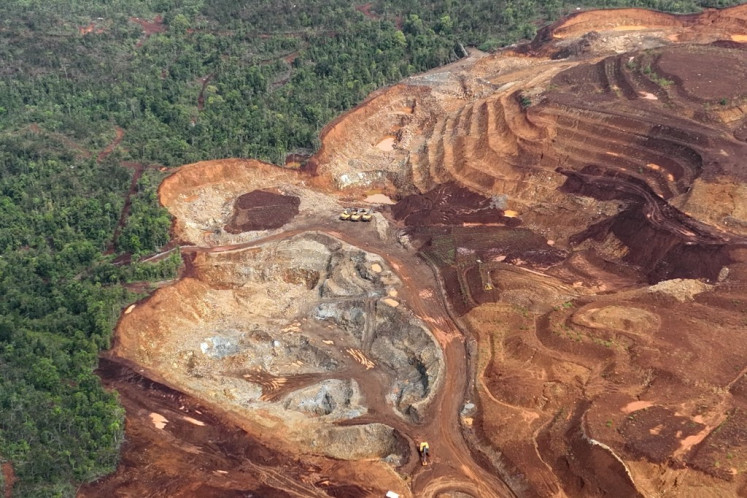Popular Reads
Top Results
Can't find what you're looking for?
View all search resultsPopular Reads
Top Results
Can't find what you're looking for?
View all search resultsLee Kong Chian Natural History Museum Celebrating the biodiversity
Marine Cycles: The Marine Cycles thematic island, where exhibition elements do not recreate specific environments, but evoke the rhythms of nature through a dynamic and engaging use of light and sound
Change text size
Gift Premium Articles
to Anyone
M
span class="caption">Marine Cycles: The Marine Cycles thematic island, where exhibition elements do not recreate specific environments, but evoke the rhythms of nature through a dynamic and engaging use of light and sound.
A new museum just opened in Singapore ' unique among its kind and the biggest in the region.
The Lee Kong Chian Natural History Museum (LKCNHM) is a permanent exhibition and an important educational institution that houses the world's largest collection of specimens from Southeast Asia as well as significant fossils that illustrate the evolution of life on Earth such as three 150-million-year-old dinosaurs.
With over 500,000 catalogued and stored specimens, a minimalist design and an innovative use of light and sound, this permanent exhibition takes visitors through the history of biodiversity and of scientific research in Southeast Asia.
This valuable depositary of the region's natural heritage consolidates Southeast Asia's position in scientific research and offers opportunities to scientists and students worldwide.
Located within the campus of the National University of Singapore (NUS), the gallery covers an area of 2,500 square meters and completes the cultural hub of Alice Lee Plaza, which connects art, science and music in the same area of the university.
Yu-Mei Balasingamchow, a writer and curator who worked on the museum's Heritage Gallery, explained that Singapore has long been a center for study of the natural world in Southeast Asia.
In fact, she said, the systematic study of the biodiversity of Southeast Asia began in the mid-19th century with European naturalists such as Alfred Russel Wallace, who classified specimens collected in the region according to Linnaean taxonomy.
'Singapore was the transit point to less accessible places such as the dense rain forests of Borneo and what were known as the Spice Islands [now the Maluku Islands]. Many naturalists and explorers traveled through Singapore and shipped their specimens from Singapore to European museum and private collections.' she said.

The museum's natural history collection began in that period as part of the Raffles Museum; it later moved to NUS and became the Raffles Museum of Biodiversity Research (RMBR), which gradually gained international recognition as one of the world's most advanced marine research centers.
Over the years, scientists' intense fieldwork and generous donations have contributed to increase the collection exponentially and, as officially stated by the museum's website and by NUS publications, the new LCKNHM was named after the founder of the Lee Foundation, the support of which has helped to implement this project, which cost around US$46 million.
'The current museum houses the largest collection of Southeast Asian specimens in the world and the oldest in Southeast Asia and represents Southeast Asia's growth in terms of cultural appropriation of contents and means.' Laura Miotto, design director of gsmprjct, said.
'Unlike traditional natural history museums, the LKCNHM does not bring visitors to exotic lands, but it offers a comprehensive look over the region's natural wonders. In fact, it is very site-specific.'
The gsmprjct team worked in close collaboration with the museum's curators and conservators, whose magic hands have revitalized and brought to visitors' appreciation over 2,000 specimens; rock fossils, microscopic organisms, plants, fungi, mollusks, arthropods, cnidarian and echinoderms, fish, amphibians, reptiles, birds and mammals.
'The collection is displayed combining a modern scientific approach to the study of biodiversity with a fresh look over interactions among living organisms and environmental issues faced by the region. Through this approach, Singapore establishes itself as the guardian of Southeast Asian natural heritage and as a well of resources for the advancement of scientific research.' explained Maude Desjardins, a museologist who developed the contents of the gallery.
Gsmprjct, the same firm that completed the galleries of the National Museum of Singapore in 2006, conceived the narrative and developed the exhibition design of the galleries at LKCNHM.
Sensational: Three dinosaurs are visible from any point of the exhibition and are undoubtedly the museum's most spectacular feature.
For this project, the team opted to arrange the rich collection following a stylish and user-friendly approach.
'The overall concept reflects the idea that Southeast Asia is a biodiversity hot spot and that Singapore provides the ideal position to observe and research it.' Laura Miotto pointed out.
'The story of the biodiversity gallery focuses on the importance of contemporary knowledge and offers insights on the Tree of Life, with the aim to develop appreciation and respect towards our living environment.'
Miotto gave a tour around the exhibition, where the space suggests an interpretative but open itinerary that allows visitors to explore the museum in different ways.
At the Biodiversity Gallery, visitors immediately embark on a kaleidoscopic adventure into the diversity of living forms.
The collection showcased in the Biodiversity Gallery on the ground floor is the entry point to the realm of living things; the minimalist design facilitates the introduction to taxonomy, the scientific classification of life and to amazing living strategies and cultural beliefs related to living things.
From birds' courtship behavior to regional recipes featuring insects, visitors can contemplate the intricacy of living forms while learning about the surrounding environment and listening to the pulsing sounds of nature.
In this open space, four thematic zones highlight fundamental landmarks in the evolution of life on Earth and important natural cycles in rain forests and coral reefs.

'Through interactives, breath-taking displays and a dynamic use of light and sound, each zone is a distinct and immersive educational experience into the wonders of nature,' Miotto explained.
On the upper floor is the Heritage Gallery, dedicated to the history of zoology in Singapore and to Singapore's ecological transformation.
Last but not least, three gigantic sauropods original fossils dominate the central hall and an ongoing light and sound-transforming scenario dramatizes their presence.
'The light design, evocative of time, follows a slow cycle of white light; it is synchronized with an original soundtrack and, every half an hour, light and sound build up a sensational climax that animates the display,' Miotto explained.
These majestic dinosaurs inspire a sense of awe that complement the wonder, curiosity and inquisitive approach elicited by the rest of the exhibition.
Conceived as a university museum and a research center, the LKCNHM is the result of the collaboration of different stakeholders and donors who took part in the making with their vision and expertise to integrate scientific knowledge with design strategies in order to create a museum that is engaging and relevant to the public.
The outcome has gone beyond expectations and, four years after the project kicked off, the LKCNHM is today a reality and a space for science, history and culture that caters to researchers and students as well as to casual visitors.

' Photos courtesy of Gsmprjct












